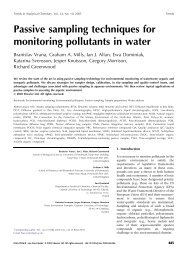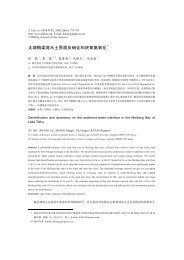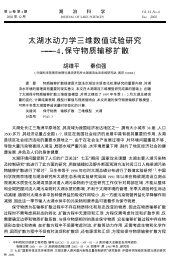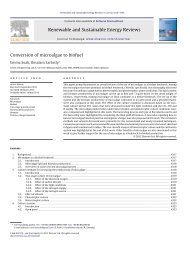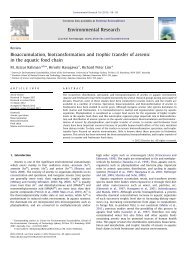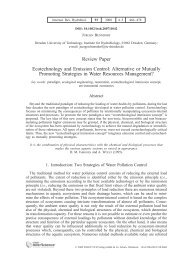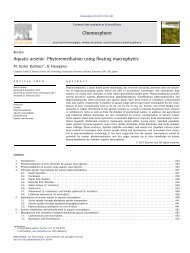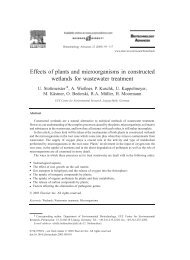The Ecology of Phytoplankton
The Ecology of Phytoplankton
The Ecology of Phytoplankton
Create successful ePaper yourself
Turn your PDF publications into a flip-book with our unique Google optimized e-Paper software.
216 GROWTH AND REPLICATION OF PHYTOPLANKTON<br />
<strong>of</strong> cysts in nature (coastal waters, eutrophic<br />
lakes) possibly occurs in response to cues that<br />
anticipate ‘adverse’ conditions rather than the<br />
actual onset <strong>of</strong> those adversities. <strong>The</strong> protoplasts<br />
<strong>of</strong> newly formed cysts usually contain conspicuous<br />
reserves <strong>of</strong> lipid and carbohydrate, accumulated<br />
during stationary growth (Chapman et al.,<br />
1980). <strong>The</strong> number <strong>of</strong> cysts produced by freshwater<br />
Ceratium hirundinella in autumn has been<br />
estimated from the sedimentary flux to account<br />
for ≤35% <strong>of</strong> the maximum standing crop <strong>of</strong> vegetative<br />
cells (Reynolds et al., 1983b). <strong>The</strong> success in<br />
recruiting vegetative cells from excysting propagules<br />
in the following spring is, in part, proportional<br />
to the abundance <strong>of</strong> spores retained from<br />
the previous year (Reynolds, 1978d; Heaneyet al.,<br />
1981).<br />
<strong>The</strong> excystment <strong>of</strong> vegetative cells from cysts<br />
was first described by Huber and Nipkow (1922).<br />
Much detail has been added from such landmark<br />
micrographic investigations as those <strong>of</strong><br />
Wall and Dale (1968) andChapman et al. (1981). A<br />
naked flagellate cell, or gymnoceratium, emerges<br />
through an exit slit and soon acquires the distinctive<br />
thecal plates <strong>of</strong> the vegetative cell. Heaney et<br />
al. (1981) noted a sharp, late-winter recruitment<br />
<strong>of</strong> new, vegetative cells <strong>of</strong> Ceratium to the plankton<br />
<strong>of</strong> Esthwaite Water, UK, after the water temperature<br />
exceeded 5 ◦ C, and coincident with an<br />
abrupt increase in the proportion <strong>of</strong> the empty<br />
cysts recoverable from the bottom sediments <strong>of</strong><br />
the lake.<br />
Among the Volvocales, sexually produced<br />
zygotes <strong>of</strong> (e.g.) Eudorina (Reynolds et al., 1982a)<br />
and Volvox (Reynolds, 1983b) have the robust<br />
appearance <strong>of</strong> resting cysts and, indeed, serve<br />
as perennating propagules between population<br />
maxima. Deteriorating environmental conditions<br />
may trigger the onset <strong>of</strong> gametogenesis but formation<br />
<strong>of</strong> the eventual resting stages cannot be<br />
claimed certainly to have been consequential on<br />
resource starvation. Among the Chrysophyceae,<br />
there has evolved an opportunistic perennation<br />
strategy, involving zygotic and asexual cysts that<br />
are produced early in the growth cycle, when conditions<br />
are supposedly good (Sandgren, 1988b).<br />
This pattern <strong>of</strong> encystment apparently ensures<br />
the production <strong>of</strong> resting stages during what<br />
<strong>of</strong>ten turn out to be short phases <strong>of</strong> environmen-<br />
tal adequacy but which are tenanted briefly by<br />
vegetative populations.<br />
In contrast, nostocalean Cyanobacteria produce<br />
their asexual akinetes in rapid response<br />
to the onset <strong>of</strong> physiological stress. Akinetes are<br />
the well-known ‘resting stages’ <strong>of</strong> such genera as<br />
Anabaena, Aphanizomenon and Gloeotrichia (Roel<strong>of</strong>s<br />
and Oglesby, 1970; Wildman et al., 1975; Rother<br />
and Fay, 1977; Cmiech et al., 1984). <strong>The</strong>se, too,<br />
have typically thickened external walls, within<br />
which the protoplast remains viable for many<br />
years. Livingstone and Jaworski (1980)germinated<br />
akinetes <strong>of</strong> Anabaena from sediments confidently<br />
dated to have been laid down 64 years previously.<br />
On the other hand, rapid akinete production has<br />
been stimulated in the laboratory by the sort <strong>of</strong><br />
carbon : nitrogen imbalance that occurs as a consequence<br />
<strong>of</strong> surface blooming, and from which<br />
conditions an effective means <strong>of</strong> escape is <strong>of</strong>fered<br />
(Rother and Fay, 1979). Moreover, substantial germination<br />
can take place shortly (days rather than<br />
months or years) after akinete formation, provided<br />
the external conditions (temperature, light<br />
and, possibly, nutrients) are suitable (Rother and<br />
Fay, 1977). Reynolds (1972) observed that Anabaena<br />
akinetes were regularly resuspended by wind<br />
action in a shallow lake but failed to germinate<br />
before a temperature or insolation threshold<br />
had been surpassed. In other years, vegetative<br />
filaments surviving the winter were sufficient to<br />
explain the growth in the following season. <strong>The</strong>se<br />
thresholds could be important to the distributions<br />
<strong>of</strong> individual species. <strong>The</strong> current spread<br />
<strong>of</strong> Cylindrospermopsis raciborskii from the tropics<br />
to continental lakes in the warm temperate belt<br />
may be delimited by a germination threshold<br />
temperature <strong>of</strong> 22 ◦ C(Padisák, 1997). <strong>The</strong> akinetes<br />
<strong>of</strong> Gloeotrichia echinulata are able to take up phosphate<br />
through their walls and colonies germinating<br />
the following year can sustain substantial<br />
growth even when limnetic supplies are small<br />
(Istvánovics et al., 1993).<br />
As suggested above, regenerative strategies are<br />
not uniform among the phytoplankton, neither<br />
is the production <strong>of</strong> spores and resting stages<br />
exclusively brought on by ‘adverse conditions’.<br />
However, the existence <strong>of</strong> resting propagules <strong>of</strong><br />
a given species are likely tolerant <strong>of</strong> more severe<br />
conditions than vegetative cells and they do



